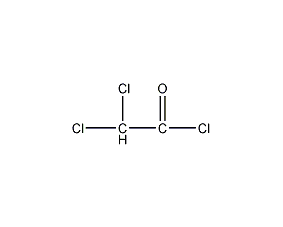
Structural formula
| Business number | 01PS |
|---|---|
| Molecular formula | C2HCl3O |
| Molecular weight | 174.39 |
| label |
dichloroacetyl chloride, Aliphatic carboxylic acids and their derivatives |
Numbering system
CAS number:79-36-7
MDL number:MFCD00000840
EINECS number:201-199-9
RTECS number:AO6650000
BRN number:1209426
PubChem number:24893840
Physical property data
1. Properties: colorless, irritating liquid
2. Density (g/mL, 25/4℃): 1.5315 (16/4℃)
3. Relative density (20℃, 4℃): 1.531516
4. Liquid phase standard hot melt (J·mol-1·K-1): 154.2
5. Boiling point (ºC, normal pressure): 108℃
6. Refractive index at room temperature (n20): 1.4591
7. Refractive index: 1.4591
8. Solubility parameter (J·cm-3)0.5:19.942
9. van der Waals area (cm2·mol-1): 7.610×109
10. van der Waals volume (cm3·mol-1): 54.580
11. Vapor pressure (kPa , 25ºC): Uncertain
12. Saturated vapor pressure (kPa, 60ºC): Uncertain
13. Heat of combustion (KJ/mol): Uncertain
14. Critical temperature (ºC): Uncertain
15. Critical pressure (KPa): Uncertain
16. Log value of oil-water (octanol/water) partition coefficient : Uncertain
17. Explosion upper limit (%, V/V): Uncertain
18. Explosion lower limit (%, V/V): Uncertain
19. Solubility: miscible with ether, will decompose when exposed to water and alcohol, and will smoke in the air.
Toxicological data
1. Acute toxicity
Rat caliber LD50: 2460mg/kg; rat inhalation LC50: 200ppm/4H;
Rabbit skin LD50: 650 uL/kg;
p>
2. Neurotoxicity
Rabbit skin test: 2mg/24HREACTION; Rabbit eye test: 50ug/24HREACTION
3. Chronic toxicity/carcinogenicity:
Mouse subcutaneous TDL0: 2mg/kg/80W-I;
4. Teratogenicity
Salmonella: 1mg/plate
Ecological data
None yet
Molecular structure data
1. Molar refractive index: 25.85
2. Molar volume (cm3/mol): 93.1
3. Isotonic specific volume (90.2K ): 229.4
4. Surface tension (dyne/cm): 36.7
5. Polarizability (10-24cm3): 10.24
Calculate chemical data
1. Reference value for hydrophobic parameter calculation (XlogP): 2.1
2. Number of hydrogen bond donors: 0
3. Number of hydrogen bond acceptors: 1
4. Number of rotatable chemical bonds: 1
5. Number of tautomers: none
6. Topological molecule polar surface area 17.1
7. Number of heavy atoms: 6
8. Surface charge: 0
9. Complexity: 59.8
10. Number of isotope atoms: 0
11. Determine the number of atomic stereocenters: 0
12. Uncertain number of atomic stereocenters: 0
13. Determine the number of chemical bond stereocenters: 0
14. Number of uncertain chemical bond stereocenters: 0
15. Number of covalent bond units: 1
Properties and stability
This product is highly irritating. Rat oral LD502.46g/kg. The production workshop should be well ventilated and the production equipment should be airtight. Operators should wear protective equipment and pay attention to eye and skin protection.
Storage method
This product should be sealed and stored in a cool, dark place. Store tightly in a brown glass bottle, protected by a wooden box, protected from sun and moisture, and stored in a cool, dry and ventilated place. Store and transport according to regulations on irritating substances.
Synthesis method
A variety of process routes can be used in the preparation method. It can be produced by the reaction of dichloroacetic acid and chlorosulfonic acid, the reaction of chloroform and carbon monoxide under the catalysis of anhydrous aluminum trichloride, the reaction of dichloroacetic acid and phosgene in dimethylformamide, and the oxidation of trichlorethylene. This product. Heat trichlorethylene and azobisisobutyronitrile (catalyst) to 100°C, introduce oxygen, react under a pressure of 0.6MPa, maintain the oil bath temperature at 110°C, react for 10 hours, and evaporate the product dichloroethyl under normal pressure. acid chloride. The by-product of this reaction, trichloroethylene oxide, can also be converted into dichloroacetyl chloride by reacting with amine compounds such as methylamine, triethylamine, and pyridine.

Purpose
Used in the synthesis of vinyl insecticides, and also used in wool felt milling finishing, bleaching, decolorization, preservation, sterilization, disinfection, etc.



 微信扫一扫打赏
微信扫一扫打赏
